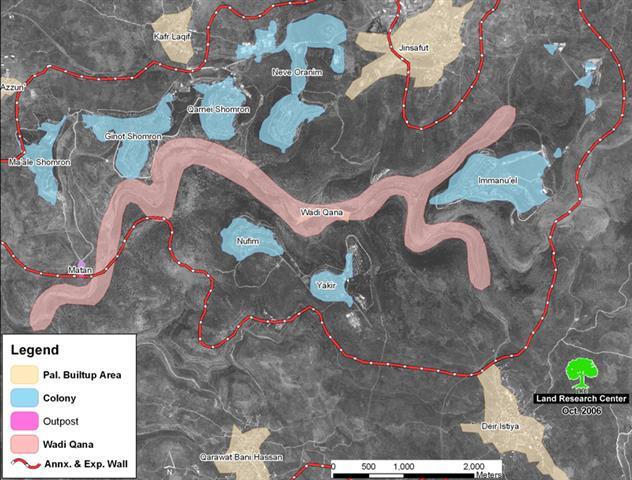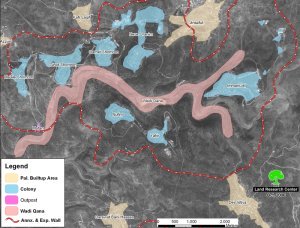Violation: Israeli occupation notifies farmer Rami Kassem Mansour from the town of Deir Stia to vacate his land.
Location: Wadi Qana area north of Salfit.
The aggressors: the Committee on the Protection of Nature of the so-called Israeli civil administration in the West Bank.
Date of notification: 13 January, 2011.
Introduction:
Wadi Qana that spot on Palestinian land which became synonymous greenery and water was and is still a destination for visitors seeking relaxation and beauty of nature from all Palestinian towns and villages,. In the past it was a source of livelihood and income for hundreds of Palestinian families in the towns of Deir Istiya and Qarawat Bani Hassan through the cultivation of all types of nuts and citrus in addition to field crops and olives.
However, the area of Wadi Qana since the Israeli occupation in 1967 is considered a victim of Israeli occupation after declaring it as a nature reserve and preventing it’s legitimate Palestinian owners from tending their agricultural lands there. This, in turn, has led to the migration of more than 200 farmers for that land because of the escalation of attacks by settlers and soldiers on the ground. On the other hand, the occupation authorities dumped the area by Israeli settlements, which are now spread all over the valley of Qana and numbered to the day seven settlements in addition to about 4 outposts spread here and there causing environmental disaster in the region as a result of domestic and industrial waste emanating from those settlements which threaten the vegetation in the region as a whole and negatively affect the biodiversity there.
Details of the violation:
Farmer Rami Kassem Nasser Al-Mansour, one of the farmers who remained steadfast in their agricultural land in the area of Wadi Qana despite continued harassment by the occupation authorities and despite threats against his life on the part of Israeli settlers he preferred to die in his land rather than giving it to those settlers who gather the mentality of land theft, murder and sabotage.
The citizen Rami Mansour was physically assaulted by settlers more than once, where he used to visit his agricultural land located within the basin number 43 known as Qatayen Al Jamal located near the Bassa spring in the southwestern side of the village of Deir Stiya. Mr. Mansour owns a piece of land there with an area of 6 dunums used in the past to cultivation of various types of citrus.
But even the trees owned by Mr. Rami Mansour had not been saved from the hatred of settlers. For example, 26 olives seedlings and an additional number of citrus trees at the age of four years have been uprooted at the hands of settlers from the nearby Yakir and Revava colonies.
Despite all this, Mr. Mansour insists to stay in his land to block attempts on the part of the settlers from ‘Yakir’ and ‘Revava’ to steal his land. To do so, he embarked on a new effort at the beginning of this year by digging new ditches in order to cultivate his land again. However, personnel from the committee for the Protection of Nature handed over Mr. Mansour military notifications to stop working in the land and vacate it as soon as possible under the threat of punishment.
It should be noted that this embodiment of the bitter reality of hundreds of Palestinian farmers in the region of Wadi Qana, where the number of farmers in the valley by 1967 was about 200 farmers but decreased in number by 2000 to about 14 farmers and now became almost deserted valley of his companions.
The area of Wadi Qana, north-west of Salfit hosts in the interior, a treasure. It is one of the aquifers in the West Bank, in addition to being a wide valley fueled by the valley of Ainabus and Jammai’n and empties into a river Auja. It is considered one of the most fertile land in Palestine, with an estimated area of about 10 thousand dunums full of archeological and historic attractions.
Referred to the settlements that surround Wadi Qana, they include: ‘Emmanuel,’ from the eastern side, ‘Yakir’ from the south, ‘Nofim’ from the West, and from the north ‘Karnei Shomron’, ‘Gardens of Shomron’ and ‘Maale Shomron’ , in addition to one outpost in the middle of the valley under the name of ‘Nof Oranim.’ In the past, these settlements serve their wastewater to the bottom of the valley, which ءforced a lot of Palestinian families residing in the place to leave.















